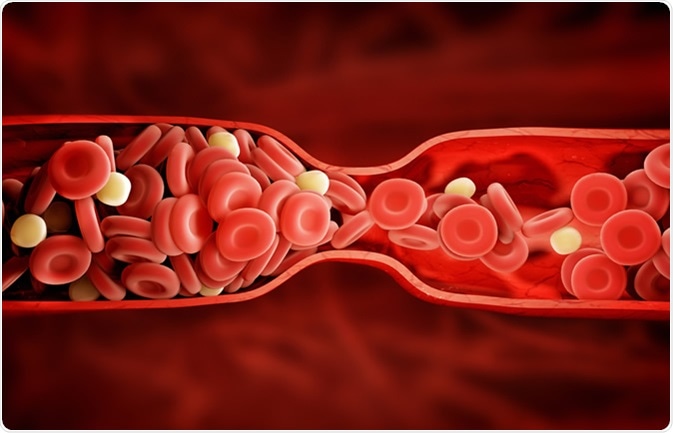Factor V Leiden is not a disease, but a genetic mutation that results in thrombophilia, a blood clotting condition that increases a person’s risk of developing abnormal blood clots in their blood vessels. People with factor V Leiden are at an increased risk of deep vein thrombosis (DVT), or a pulmonary embolism (PE), but some carriers of the mutation do not develop thrombosis. Factor V Leiden is the most common form of inherited thrombophilia.
Skip to

Factor V Leiden results in thrombophilia, a blood clotting condition that increases a person’s risk of developing abnormal blood clots. Image Credit: Adike / Shutterstock
What is Factor V?
Factor V is a coagulation protein in the blood. Its function is to promote normal coagulation after an injury occurs.
The following steps describe the normal clotting process when blood vessels are damaged:
- Platelets move to the site of the injury on the blood vessel and form a plug.
- Enzyme reactions, which include the protein factor V, take place on the surface of the platelets to convert fibrinogen to fibrin, which secures the platelets to the injury site. The mix of platelets and fibrin are called clots.
- Activated protein C (APC) deactivates factor V and stops the clot from becoming too large.
- Enzymes repair the damage to the blood vessel while the clot remains attached to the injury site.
In factor V Leiden, the mutated factor V is resistant to inactivation by APC. This means that clots continue to grow and the coagulation (or clotting) process stops more slowly.
Factor V Leiden Epidemiology
Between three and eight percent of people with European ancestry may carry one copy of the factor V Leiden mutation in each cell. Approximately one person in every 5,000 people possesses two copies of the mutation.
The mutation has been found to be less common in other populations, including Hispanic, Asian, African, and Native American populations.
Symptoms of Factor V Leiden
Symptoms of Factor V Leiden can vary. Some people with the factor V Leiden mutation have multiple thrombotic episodes before the age of 30 years, while others never develop thrombosis. This variability is ascribed to the differences in the number of gene mutations in different individuals.
The common symptoms of Factor V Leiden include:
- Having DVT or PE before the age of 50
- Having recurring DVT or PE
- Having venous thrombosis in the brain or the liver
- Having DVT or PE during or immediately after pregnancy
- A history of unexplained pregnancy loss in the second or third trimester
- Family history of venous thromboembolism.
Factor V Leiden diagnosis
To diagnose factor V Leiden, a coagulation screening test is ordered. This test provides information to determine whether hemostatic disorders (conditions that impair the body’s ability to stop bleeding) are present. A typical coagulation screen includes a platelet count, bleeding time for platelet function, fibrinogen assay, prothrombin ratio, and activated partial thromboplastin time (aPTT).
Additionally, genetic testing can determine whether a patient has factor V Leiden thrombophilia. This will also determine whether a patient has heterozygous (one mutated factor V gene and one normal factor V gene) or homozygous (two copies of the mutated factor V genes) factor V Leiden.
Additional risk factors for thrombosis in women with Factor V Leiden
Other gene mutations that affect blood clotting may also contribute to the severity of symptoms experienced.
Oral contraceptives
The use of oral contraceptives can increase a healthy woman’s chances of developing DVT or PE by three to four times when non-users.
Women with the factor V Leiden mutation who also take oral contraceptives have an increased risk of developing DVT or PE by about 35 times when compared with women who do not have the mutation.
Hormone replacement therapy
Post-menopausal women who take hormone replacement therapy (HRT) may increase their chances of developing DVT or PE by two or three times when compared to women not taking HRT.
Women with the factor V Leiden mutation who take HRT increase their risk of DVT or PE by 15 times compared to women taking HRT who do not possess the genetic mutation.
Risk factors for DVT and PE
Approximately one in every 1000 people develop DVT or PE every year, with this figure increasing from approximately one in 10,000 people in their twenties to approximately five in every 1000 people in their seventies.
Other risk factors that increase a person’s risk of developing DVT or PE include:
- Obesity
- Cancer
- Immobility
- Surgery
- Trauma
- Pregnancy
- Diabetes
- Air travel
- Hereditary thrombophilia
- Certain blood conditions.
Treatment for Factor V Leiden
There is no treatment that will ‘cure’ factor V Leiden. Patients with factor V Leiden who have had deep vein thrombosis or a pulmonary embolism will be treated with anticoagulants (also called blood-thinners), which are medications that prevent blood clots by interrupting the clotting process. Lifelong anticoagulation is not recommended, however, in the absence of additional risk factors.
Instead of prolonged anticoagulation, lifestyle changes can be made to reduce a person’s overall risk of developing DVT or PE as a result of factor V Leiden. Such measures include:
- Maintaining a good weight for the height and sex
- Regular exercise
- cessation of smoking
- Avoiding long periods of immobility
- Controlling conditions like diabetes or high cholesterol
Further Reading
Last Updated: May 21, 2019